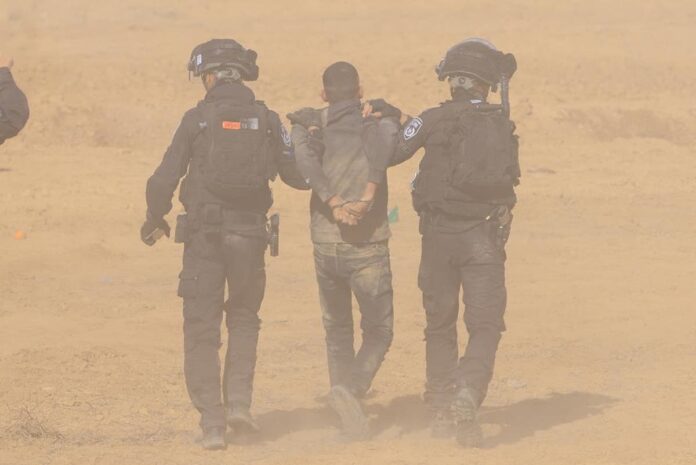Last Thursday, thousands gathered in the Naqab region (Negev), southern Israel, to protest the dispossession of Palestinian Bedouin communities – and the response from the Israeli state was brutal.
Heavily-armed Israeli police showered crowds with tear gas launched from drones, while opening fire with rubber-coated metal bullets. Three people were hit directly in the face and needed surgery. One of them, Talib al-Sa’aydeh, suffered an internal haemorrhage.
The demonstration came after three days of sustained struggle led by residents of Al-Sua’a village who were resisting an afforestation initiative being carried out by the Jewish National Fund (JNF) – a quasi-state body – with the support of the Israeli authorities. No simple “green” initiative, this is afforestation as dispossession and displacement.
In a continuation of the settler-colonial discourse that has always been a feature of Zionist settlement in Palestine, JNF and Israeli officials claim that the Bedouins have no claim to private property and that the land is state land.
Afforestation has a long history in Palestine as a political tool for Israeli authorities – used to hide the history of Palestinian presence by planting forests over the ruins of Palestinian villages destroyed in the Nakba. It has also been a mechanism of holding the land and preventing displaced communities from returning. The targeted land constitutes valuable agricultural land – what is going on, therefore, is an attack on people’s very livelihoods and is seen as a precursor for their displacement.
In the Naqab specifically, afforestation is just one way that Israel has sought to displace Bedouin Palestinians and eliminate their presence on the majority of the land.
Al-Sau’a village is one of thirty six Palestinian Bedouin villages in the Naqab which Israel refuses to recognise. Some 100,000 of the region’s 300,000 Palestinian population live in such villages. These villages are deemed “illegal” by Israel and are deprived of basic access to infrastructure and services. All of these villages are destined for erasure and their residents displaced.
That is why those who have mobilised and protested see the attack on Al-Sau’a as being much broader than the fate of one specific village. It is why the confrontations with the JNF and armed police forces began with local residents – but slowly gathered steam as more joined from the region.
At last week’s demonstration, the protesters were primarily young – no doubt in part a reflection of the fact that over 50 per cent of the Naqab’s Palestinian Bedouin population are under 17 years old. There was also a very strong presence of women, a feature that is increasingly shaping the Palestinian struggle as a whole.
The spirit was very determined, and open to self-defence and confrontation – understanding that the repercussions of this mobilisation were, and are, severe. Aside from the aforementioned brutal force used by Israeli forces, there have been waves of arrest raids calculated to crush people’s spirits.
As of 19 January, some 150 people had been arrested since 10 January, some 40 per cent of them are minors, 17 of whom remain in custody. Five protestors are being held by Israel’s security services and are denied legal representation. Mass arrests are a familiar strategy used by Israeli authorities as a disciplining mechanism against those who would dare to protest their dispossession.
The events in the Naqab sparked a wave of demonstrations across different Palestinian communities. For Palestinians, the struggle in al-Sau’a village and the Naqab more generally is not a localised one, but one in which they see a familiar story of dispossession and displacement. The level of violence used to repress protests proved in practice, that regardless of their citizenry status (Palestinians in the Naqab are Israeli citizens), Palestinians everywhere face the raft of Israel’s security forces.
To keep up to speed with all the latest opinions and comment, sign up to our free weekly Voices Dispatches newsletter by clicking here
These interlocking dynamics of unity in resistance and repression were the spirit of May 2021 – when Palestinians everywhere rose up against the displacement taking place in Sheikh Jarrah, Jerusalem.
Current events show that the flame ignited in those days was not extinguished – including in the Naqab, a region Israel has tried so hard to disconnect politically from wider Palestinian mobilisation. The current protests against dispossession and displacement indicate that Israel’s perceived absolute control is an illusion.
The only avenue we have here is to continue to collectively build a base for action. For years, Israel has worked to crush grassroots organising. Thus, the only way to keep going forward is to build structures that work in our interests – separate from the political establishment.
Ultimately, the Naqab cannot be disconnected from the rest of Palestine, if we are to achieve any meaningful change, secure our dignity, and have our communities – and their land – recognised.
Riya Al’Sanah is a Palestinian researcher and activist from Lakiya village in the Naqab
Credit: Source link










